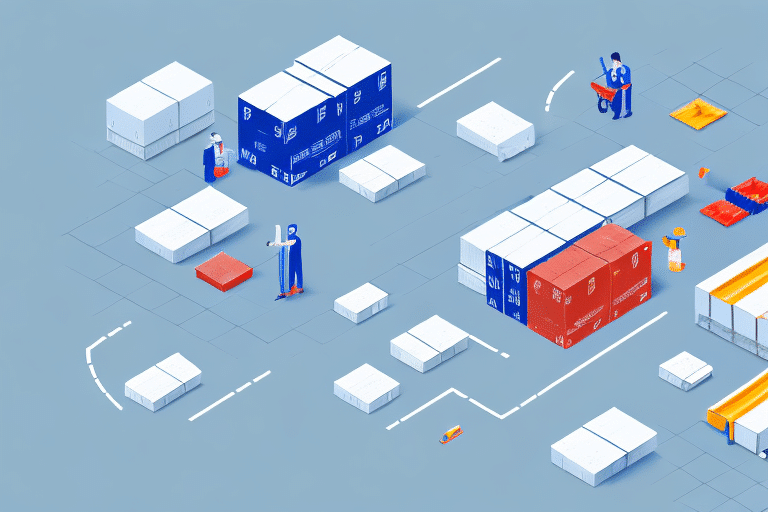How to Connect, Optimize, and Manage DHL eCommerce for Inventory Management
If you're seeking a premium inventory management system, DHL eCommerce should be a top contender. Renowned for its trusted logistics services, DHL eCommerce offers a robust and efficient platform that can streamline your operations and foster business growth cost-effectively.
Why DHL eCommerce is a Top Choice for Inventory Management
One of the primary advantages of using DHL eCommerce for inventory management is its extensive global network. With a presence in over 220 countries and territories, DHL eCommerce facilitates seamless connections with suppliers and customers worldwide, enabling you to expand your market reach effortlessly.
In addition to its global footprint, DHL eCommerce provides reliable and swift shipping options, ensuring your products reach their destinations promptly and efficiently. This reliability helps avoid costly delays and minimizes customer complaints, maintaining smooth and profitable business operations.
DHL eCommerce also boasts advanced tracking and monitoring capabilities. Real-time tracking updates allow you to monitor shipments closely, ensuring timely deliveries and providing the ability to proactively address any issues, such as customs delays or weather-related disruptions.
Moreover, DHL eCommerce offers a variety of customizable solutions tailored to the unique needs of your business. Whether you require assistance with warehousing, order fulfillment, or returns management, DHL eCommerce can provide personalized solutions that fit your specific requirements, making it an ideal choice for businesses of all sizes and industries.
Understanding the Benefits of DHL eCommerce for Your Business
DHL eCommerce goes beyond traditional shipping services by offering a comprehensive suite of inventory management tools designed to optimize your operations and drive business growth. These tools include:
- Real-time inventory tracking and forecasting
- Automated order fulfillment and shipping
- Integrated third-party logistics services
- Data analytics and reporting
- Customizable user interfaces and dashboards
Utilizing these tools provides a deeper understanding of your inventory levels, sales trends, and customer preferences, enabling informed business decisions, reducing inventory holding costs, and boosting your bottom line.
Value-Added Services
Beyond inventory management, DHL eCommerce offers a range of value-added services to enhance customer experience and build brand loyalty:
- Customized packaging and labeling
- Flexible delivery options, including same-day and next-day delivery
- Easy returns management
- International shipping and customs clearance
- Dedicated customer service support
Leveraging these services ensures a seamless and hassle-free shopping experience for your customers, differentiating your business from competitors and encouraging repeat business.
Sustainability and Social Responsibility
DHL eCommerce is committed to sustainability and social responsibility, implementing initiatives to reduce its carbon footprint and support local communities:
- Investing in renewable energy and energy-efficient technologies
- Reducing waste and promoting recycling
- Supporting local charities and community projects
- Providing training and development opportunities for employees
- Ensuring ethical and responsible business practices
Partnering with DHL eCommerce not only enhances your operational capabilities but also aligns your business with sustainable and ethical practices, contributing to a more equitable future.
Setting Up Your DHL eCommerce Account for Inventory Management
Getting started with DHL eCommerce involves creating an account and setting up your inventory management system. Follow these steps to begin:
- Sign up for a DHL eCommerce account and select a suitable plan based on your business needs.
- Configure your account information, including billing details and shipping preferences.
- Integrate your inventory management software with the DHL eCommerce platform.
- Sync your product catalog with DHL eCommerce to ensure accurate inventory tracking.
- Set up your fulfillment and shipping preferences to align with your business operations.
- Configure your reporting and analytics settings to monitor performance metrics effectively.
Once your account is established, you can utilize the diverse tools and features of the DHL eCommerce platform to manage inventory, process orders, and streamline logistics operations efficiently.
DHL eCommerce offers various shipping options tailored to your business needs, including standard, expedited, and international shipping. Additionally, it provides comprehensive tracking information for all shipments, keeping your customers informed about the status of their orders. This ensures that your inventory management and shipping processes are both efficient and reliable.
Integrating Your Inventory Management Software with DHL eCommerce
To fully capitalize on DHL eCommerce's capabilities for inventory management, integrating it with your existing inventory management software is essential. This integration can be achieved through various APIs and integration tools, depending on your software provider and specific business requirements.
Generally, the integration process involves setting up data mapping between your inventory management system and the DHL eCommerce platform. This ensures seamless transfer of product information, order details, and shipping preferences, eliminating redundant data entry and keeping inventory levels and shipping information updated in real-time.
It's important to note that the integration process may require technical expertise. Collaborating with a qualified developer or integration specialist can ensure a smooth and successful integration. Additionally, some inventory management software providers offer pre-built integrations with DHL eCommerce, simplifying the process and reducing the need for custom development.
Best Practices for Optimizing Your DHL eCommerce Inventory Management System
Maximize the benefits of your DHL eCommerce inventory management system by adhering to the following best practices:
- Regularly update your product catalog and inventory levels to reflect accurate stock information.
- Automate order fulfillment and shipping processes to enhance efficiency and reduce manual errors.
- Set up alerts and notifications for low inventory levels and potential shipping delays to proactively address issues.
- Monitor shipping costs continuously and adjust your shipping strategies as needed to optimize expenses.
- Leverage data analytics and reporting tools to gain insights into sales trends and customer behavior.
Additionally, regularly review and update your shipping policies to determine the most effective shipping carriers and methods for your business. Clearly communicate delivery times and costs to customers to set accurate expectations. Implementing a system for handling returns and exchanges, such as a dedicated returns portal and clear return instructions, ensures efficient processing and customer satisfaction.
Advanced Techniques for Managing Your Inventory with DHL eCommerce
Elevate your inventory management by implementing advanced techniques with DHL eCommerce:
- **Implement RFID Tagging and Scanning:** Enhance inventory accuracy and efficiency by using RFID technology for tracking.
- **Utilize Artificial Intelligence and Machine Learning:** Predict inventory demand and optimize your supply chain using advanced algorithms.
- **Integrate with Accounting and Finance Systems:** Streamline financial processes by linking your inventory management software with your accounting systems.
- **Leverage Cross-Border eCommerce Services:** Expand your global reach and sell in multiple markets by utilizing DHL eCommerce's international services.
Moreover, adopting a just-in-time (JIT) inventory management system can significantly reduce holding costs and minimize waste. JIT involves ordering and receiving inventory only when needed, ensuring you maintain optimal stock levels to meet customer demand without overstocking.
Common Mistakes to Avoid When Using DHL eCommerce for Inventory Management
While DHL eCommerce is a powerful inventory management system, businesses can make several common mistakes that hinder its effectiveness:
- **Failing to Sync Inventory Levels:** Not synchronizing your inventory levels with the DHL eCommerce platform can lead to stockouts or overstocking.
- **Neglecting Automated Processes:** Not setting up automated order fulfillment and shipping processes can result in delays and customer dissatisfaction.
- **Ignoring Shipping Costs:** Failing to monitor and adjust shipping strategies based on costs can lead to inefficiencies and increased expenses.
- **Overlooking Data Analytics:** Not leveraging data analytics and reporting tools prevents you from gaining valuable insights into inventory levels and sales trends, leading to missed opportunities and poor business decisions.
- **Insufficient Staff Training:** Not properly training staff on using the system can cause data entry errors, inaccurate inventory levels, and order fulfillment delays.
To avoid these pitfalls, adhere to the best practices outlined earlier, ensure regular monitoring of inventory and shipping processes, and provide comprehensive training to all relevant staff members.
Leveraging Data Analytics to Improve Your DHL eCommerce Inventory Management Strategy
A significant advantage of using DHL eCommerce for inventory management is its robust data analytics and reporting tools. By analyzing sales trends, inventory levels, and customer behavior, you can optimize your inventory management system and drive business growth. Consider the following strategies to leverage data analytics effectively:
- **Track Inventory Turnover Rate:** Identify slow-moving products that may require discounting or liquidation to free up storage space and reduce holding costs.
- **Monitor Sales Trends:** Adjust inventory levels based on sales patterns to prevent stockouts and overstocking, ensuring you meet customer demand efficiently.
- **Segment Customers:** Group customers based on purchasing behavior and tailor your marketing and sales strategies to each segment for more personalized engagement.
- **Analyze Shipping Costs:** Evaluate your shipping expenses to identify opportunities for reducing costs without compromising service quality.
Additionally, implementing predictive analytics can forecast future trends and demand, allowing you to anticipate product needs and adjust inventory levels proactively. This foresight reduces the risk of stockouts and overstocking while enabling you to identify and capitalize on emerging market opportunities.
Maximizing Efficiency and Cost Savings with DHL eCommerce for Inventory Management
To fully maximize the benefits of DHL eCommerce for inventory management, focus on enhancing efficiency and achieving cost savings through the following strategies:
- **Optimize Inventory Levels:** Maintain optimal stock levels to reduce holding costs and prevent stockouts, ensuring efficient use of resources.
- **Automate Processes:** Streamline order fulfillment and shipping processes through automation to reduce labor costs and improve accuracy.
- **Utilize Integrated Logistics Services:** Leverage DHL eCommerce's integrated logistics services to optimize your supply chain and lower shipping costs.
- **Implement Lean Six Sigma Methodologies:** Apply Lean Six Sigma principles to eliminate waste and enhance process efficiency, driving continuous improvement.
By concentrating on these areas, you can ensure that your inventory management system operates at peak performance, supporting sustainable and profitable business growth.






















